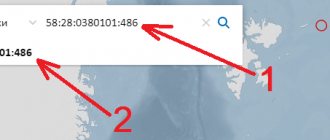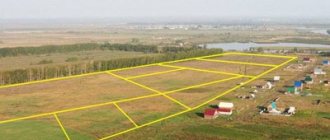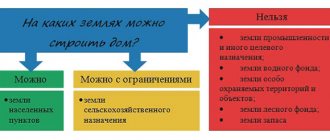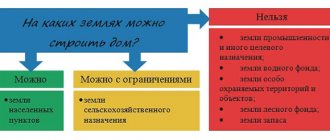The legislative framework
All agricultural lands are a large category defined by the Land Code of the Russian Federation in paragraph 1 of Article 77. The purpose of agricultural land plots is divided into groups according to the types of permitted use:
- for farming;
- for running a peasant farm;
- for organizing agricultural production;
- for country house construction;
- for gardening activities;
- for livestock;
- other options.
You can learn more about the characteristics and types of permitted use of agricultural land in a separate article.
The delimitation of land by types of permitted use is based on Order No. 540 of the Ministry of Economic Development, dated September 1, 2014. In addition to the main and additional VRI, there are conditional permits. Such types are indicated for a specific site in urban planning regulations in accordance with the Land Use and Development Rules. These are separately allocated territories for which it is impossible to change the VRI. These include forest lands and especially valuable agricultural lands.
Important! Activities carried out on a land plot that do not correspond to its type of permitted use entail administrative liability.
You can get acquainted with the legal regime and features of the use of agricultural land here.
How and in what cases should the type of permitted use of a land plot be changed?
October 11, 2021
Type of permitted use (AU) is a publicly established permissible functional use of a land plot, existing capital facilities and those being built on it, i.e. the type of activity for which the land plot and real estate located on it can be used. You can use a plot, even if it is owned, only in accordance with its belonging to a certain category of land and the type of permitted use.
The classifier of types of permitted use of land plots was approved by order of the Federal Service for State Registration, Cadastre and Cartography dated November 10, 2021 N P/0412.
VRI is an additional characteristic of a land plot, information about which is contained in the Unified State Register of Real Estate (USRN). To find out the VRI of a plot, it is enough to know its address, cadastral number and use one of the following methods:
— order an extract from the Unified State Register of Real Estate on the main characteristics of the property;
— use the Rosreestr “Public Cadastral Map” service.
It is important that to change the type of permitted use of a land plot, you must be guided by the rules of land use and development (LRU). These rules are drawn up in the form of a document that contains urban planning regulations and zoning maps.
First, you need to clarify whether the PZZ has been accepted by the authorized body in your locality.
In accordance with the law, in the presence of approved PZZ, the owner of the land plot, except for cases provided for by law, has the right to independently, without additional permits and approvals, choose the type of permitted use of the land plot from among the types provided for by the town planning regulations.
In this case, the owner needs to submit an application to any convenient MFC office about the selected type of permitted use of the land plot from those types established by the PZZ. The form of such an application is approved by Appendix No. 2 to the order of Rosreestr dated August 19, 2020 No. P/0310.
Please note that changing the VRI of a land plot to a type classified as conditionally permitted is possible only on the basis of a decision of the authorized body based on the results of public discussions or public hearings.
IMPORTANT! A change in the type of permitted use of a land plot may entail a change in its cadastral value, as well as the amount of land tax.
When might change be needed?
The VRI of a site does not always fit the plans of the owner or potential buyer. The growing demand for suburban real estate leads to the need to transform special categories of land into plots suitable for the construction of residential buildings (we talked about whether it is possible to build a house on agricultural land, and which one exactly). Also, a change in the VRI is required if it is planned to build a retail outlet or industrial premises. In this way, you can significantly increase the value of a land plot when you plan to resell the land (how is the cadastral value of agricultural land determined?).
Current methods
First
Changing the current category is a long and labor-intensive job. The legislation clearly defines the entire procedure and deadlines for implementation. The change of category of the Federal Law of the Russian Federation “On the transfer of lands or land plots from one category to another” is regulated (as amended as of July 29, 2017). Such a translation is necessary in cases where it is planned to:
- construction of commercial real estate or industrial buildings;
- construction of an apartment building or organization of a nature reserve.
We talked in detail about the features of transferring agricultural land to another category and how it is carried out in this material.
Second
A change in the VRI of agricultural land (without removing it from the current category) is necessary in order to use an agricultural land plot for gardening, construction of a private house or construction of other buildings (is it possible to build on agricultural land?), which is impossible under the current VRI. The procedure for changing the VRI is provided for by the Land Code of the Russian Federation in Article 8, where all the requirements are clearly described.
Analytics Publications
Guided by Article 7 of the Land Code of the Russian Federation, courts recognize the use of a land plot as inappropriate if the plot is used not in accordance with its belonging to one or another category of land.
It should be noted that courts often use the term “misuse of a land plot” also in the case of using a plot not in accordance with the type of permitted use (APU) established for it.
The consequence of this, in particular, may be a requirement for the demolition of unauthorized buildings.
Let's consider several examples of the courts' qualification of the defendant's actions in connection with the plaintiff's arguments about the misuse of a land plot.
The Supreme Court of the Russian Federation supported the conclusions of the lower courts, which recognized the defendant’s actions as inappropriate use of the land plot and ordered the demolition of the buildings erected on this site[1].
The court found that the defendant, who is the owner of a land plot classified as agricultural land (agricultural land), erected hangars on its territory. According to the defendant, these buildings were intended for storing agricultural products. At the same time, the prosecutor who filed claims for the demolition of these buildings presented to the court evidence of the use of hangars for storing aircraft. As a result, the court supported the prosecutor's arguments about the defendant's misuse of the land plot and ordered the demolition of these buildings.
Of interest is the position of the courts that the inappropriate use of a building (part of it) located on a land plot is not a sign of inappropriate use of the land plot[2]. This position seems uncontroversial, since in fact the economic activity of a person on a land plot is determined precisely by how the objects located on it are used, and the inappropriate use of real estate is directly related to the inappropriate use of the land plot.
For example, the Arbitration Court of the Moscow District found that the owner of a land plot, which was assigned a VRI - operation of a warehouse complex, uses the warehouse premises located on it to locate offices[3]. The court, however, did not agree with the arguments of the Rosreestr Office that this fact indicates the misuse of the land plot. On the contrary, the court indicated that the use of premises in a non-residential building relates to the issue of the use of real estate, not land.
A similar approach was applied by the Court of the Central District in case No. A08-72/2017, which established that one of the premises of a non-residential building for industrial purposes, located on a land plot that has a VRI - for the placement and operation of industrial buildings and structures, is used in trading activities.
At the same time, in another case, the court declared illegal the actions of the defendant in the construction and operation of a shopping pavilion on a land plot that has a temporary construction site for servicing the club building. The court rejected the defendant’s arguments that he uses the shopping pavilion to service the club and, therefore, its construction on a land plot does not indicate misuse of such a plot[4].
Let us also dwell on court case No. 31-AD17-5, considered by the Supreme Court of the Russian Federation on May 12, 2021.
In this case, the owner of a land plot classified as residential land and having a VRI for the operation of a garage box placed a support for a cellular radiotelephone network station with the appropriate equipment on the roof of the garage box. Thus, according to the Rosreestr Office, the owner did not use the land for its intended purpose. The court did not agree with this position, stating the following.
The classifier of types of permitted use of land plots [5] (Classifier) establishes that the content of the VRI allows, without a separate indication in the Classifier, the placement and operation of a linear facility (except for public railways and public roads of federal and regional significance), the placement of protective structures ( plantings), land reclamation objects, antenna-mast structures, information and geodetic signs, unless otherwise provided by federal law.
Based on the specified provision of the Classifier and the explanations of the Ministry of Economic Development of the Russian Federation, given in letter No. D23i-1239 dated March 18, 2016, the court came to the conclusion that the placement of antenna mast structures is allowed on land plots with any VRI (including on land plots with in the VRI of which the location of communication facilities is not specifically stipulated) without additional cadastral registration of changes in terms of the permitted use of the land plot.
In addition to cases of inappropriate use of a land plot, it should be noted that the use of a land plot not in accordance with the purpose of its provision, specified, for example, in a lease agreement, may become grounds for termination of this agreement, as well as the application of contractual liability, if any [6 ]. In particular, for failure to comply with the purpose of providing a land plot, a penalty or rent may be charged, calculated taking into account an increasing factor.
At the same time, the fact of using the land plot in accordance with its intended purpose (that is, the absence of violations associated with the use of the land plot not in accordance with the category of land and VRI) does not exclude the civil liability of the tenant for the use of the land plot not in accordance with the purpose of its provision and the tenant's right to demand termination of the contract.
For example, the Moscow Arbitration Court satisfied the tenant’s request to terminate the lease agreement for a land plot provided for the purpose of operating a cafe building after the cafe was demolished by the tenant[7]. The court indicated that the demolition of the cafe building should be qualified on the basis of Article 451 of the Civil Code of the Russian Federation as a significant change in circumstances, giving the land lessor the right to early termination of the lease agreement.
Courts satisfy demands for termination of a lease agreement under similar circumstances, also applying the provisions of Article 450, paragraph 1 of Article 619 of the Civil Code of the Russian Federation on a significant violation of the terms of the agreement as a basis for its termination.
At the same time, not only the fact of misuse of a land plot can become a basis for prosecution, but also non-use of a land plot in cases provided for by parts 2, 2.1 and 3 of the Code of Administrative Offenses of the Russian Federation.
Let us consider individual issues of liability for misuse of land in more detail.
1. Bringing to administrative liability
Administrative liability for misuse of land is established by Part 1 of Art. 8.8 of the Code of Administrative Offenses of the Russian Federation, while this article covers the use of the site both not in accordance with its intended purpose, taking into account its category, and in violation of the VRI.
According to statistics published by Rosreestr (authorized to consider this category of cases), as of 01/01/2016[8] 5,861 persons were held accountable for using land plots other than their intended purpose, the total amount of fines imposed amounted to more than 200 million rubles, However, less than half of the identified violations were eliminated - only 2,625.
Sanction for committing an offense under Part 1 of Art. 8.8 of the Code of Administrative Offenses of the Russian Federation is a fine. Since March 2015, the amount of fines has been significantly increased, and a new mechanism for calculating the fine has been established: in an amount that is a multiple of the cadastral value of the site. So, now an organization can be fined in the amount of 1.5 to 2% of the cadastral value of the site, but not less than 100 thousand rubles. (previously, the liability of organizations was limited to 50 thousand rubles)
It should be noted that the qualification of actions under Part 1 of Art. 8.8 of the Code of Administrative Offenses of the Russian Federation does not affect the misuse by a person of only a part, and not the entire land plot[9].
The controversial issue is related to the jurisdiction of cases of appealing prosecution under Part 1 of Art. 8.8 Code of Administrative Offenses of the Russian Federation. Thus, many arbitration courts, guided by the explanations of the RF Armed Forces[10], indicate that this violation relates to violations in the field of environmental management, is not related to business activities and cannot be considered in an arbitration court[11].
On the contrary, in other cases, higher courts point out the illegality of termination of proceedings in the case by the arbitration court, since bringing to liability under Part 1 of Art. 8.8 of the Code of Administrative Offenses of the Russian Federation directly affects the economic (entrepreneurial) interests of a person and cannot be appealed in courts of general jurisdiction[12].
2. Obligation to bring the land plot into a usable (original) condition
Elimination of violations of the intended use of a land plot in kind is a common way to protect rights to a land plot and protect the land plot as a natural object.
The requirement to restore the site to its original condition may be associated with the obligation to free it from illegally placed non-capital objects, such as trade tents, as well as unauthorized real estate [13]. Bringing land plots into a usable condition is carried out by the violators themselves or at their expense (clause 2 of article 62 and clause 3 of article 76 of the Land Code of the Russian Federation).
When considering demands to bring a land plot to its original condition, the courts also oblige the violator to ensure reclamation of the site and restore the soil layer disturbed as a result of its misuse. First of all, such requirements are stated in relation to agricultural land plots[14].
In this case, the court may oblige the person who has already carried out the reclamation of the damaged land plot to compensate for the damage in monetary form. Such a “double” recovery is applicable if the court finds that restoration of the condition of the land plot is only partially possible, including due to the presence of irreparable environmental losses, and therefore the damage must be compensated in full not only in kind, but also in cash [15].
3. Recovery of losses caused by misuse of land
Often, inappropriate use of a land plot leads to damage to the site as a natural object. At the moment, extensive judicial practice has been formed on compensation for damage caused to land plots[16]. At the same time, the provisions of land and civil legislation are applied by the courts in close connection with the norms of environmental legislation[17].
Causing damage to a land plot may be associated, for example, with the unlawful use of the site for storing waste, building materials, paving over part of the site, or placement of real estate [18]. The issue of assessing the size and compensation of damage is especially acute in relation to agricultural land plots.
To recover damages from the violator, it is necessary to prove the existence of harm, its size and the cause-and-effect relationship between the actions of the person and the harm caused. In this case, the amount of damage is determined in accordance with approved rates and methods, for example, the Methodology for calculating the amount of damage caused to soils as an object of environmental protection[19].
In addition to compensation for damage caused by misuse, other damages may be recovered from the violator, for example, the costs of the owner of the land plot for the demolition (dismantling) of objects erected not in accordance with the permitted use of the site, as well as lost profit of the owner of the land plot due to the impossibility of using it .
4. Termination of the rights of tenants and land users to a land plot, including seizure of a land plot from the owner
The grounds for the forced termination of limited rights to land (in particular, the right of permanent (indefinite) use) and lease rights, free use of a plot are the use of a land plot for other than its intended purpose, as well as the use of a plot that leads to damage to the land, failure of the right holder to fulfill the obligation for reclamation and restoration of the condition of the site. Let us note that, based on the literal interpretation of the relevant provisions of the Land Code of the Russian Federation (Articles 45–47), the use of a site not in accordance with its permitted use is not included among such grounds.
At the same time, based on established practice, many land lease agreements include a condition on the right of the lessor to unilaterally, out of court, refuse to fulfill the agreement if the tenant violates both the permitted use and the purpose of leasing the plot.
Article 285 of the Civil Code of the Russian Federation, in turn, provides that a land plot can be seized from the owner if its use is carried out in violation of legal requirements, in particular, not in accordance with its intended purpose. In judicial practice, there are isolated and exceptional cases of application of this norm, which allows us to evaluate this instrument as declarative and in fact not working.
At the same time, in judicial practice there are examples of judicial seizure of land plots from the owner on special grounds established for agricultural land plots.
According to Art. 6 of the Federal Law of July 24, 2002 No. 101-FZ “On the turnover of agricultural land”, a land plot can be seized from the owner in court if its use leads to a significant decrease in land fertility[20], as well as in case of non-use within three and more than a year in a row a plot for farming, if violations in its use were previously identified as part of land supervision.
Note that the vast majority of land seizures are associated precisely with the non-use of plots for agricultural production[21].
However, in general, the institution of seizure of land plots due to inappropriate use, in contrast to the mechanism for terminating the right to lease, is not developed in law enforcement practice. Most likely, the reason lies in the fear of the courts to take such an extreme measure as terminating the property rights of the violator.
5. Other types of liability and negative consequences of misuse of land
Articles 74 and 75 of the Land Code of the Russian Federation also provide for criminal (Article 254 “Damage of land”) and disciplinary (applied to employees and officials) types of liability that can be applied in case of misuse of land plots.
Do not forget that the placement of a building or structure on a land plot not in accordance with its permitted use indicates the unauthorized use of the building, subject to demolition by court decision (Clause 1 of Article 222 of the Civil Code of the Russian Federation).
Among other consequences of inappropriate use, we also mention an increase in the land tax rate in relation to agricultural land plots not used for agricultural production (clause 1 of Article 394 of the Tax Code of the Russian Federation).
Thus, inappropriate use of land plots is fraught with significant negative consequences of both material and non-property nature, which must be taken into account by current land users and persons acquiring rights to land plots.
[1] Determination of the Supreme Court of the Russian Federation dated August 2, 2016 No. 35-KGPR16-12.
[2] See, for example, the resolution of the Supreme Court of the Russian Federation dated February 20, 2015 in case No. A41-20594/14.
[3] Resolution of the Arbitration Court of the Moscow District dated July 11, 2017 in case No. A40-151922/2016.
[4] Resolution of the Supreme Court of the Russian Federation dated March 24, 2016 No. 31-AD16-3.
[5] Approved by order of the Ministry of Economic Development of the Russian Federation dated September 1, 2014 No. 540.
[6] Rulings of the Supreme Court of the Russian Federation dated February 17, 2017 in case No. A81-293/2016; dated February 17, 2016 in case No. A40-206687/2014; Resolution of the Arbitration Court of the Moscow District dated May 29, 2017 in case No. A40-102752/16; Resolution of the Arbitration Court of the Ural District dated September 16, 2015 in case No. A60-38963/2014.
[7] Resolution of the Moscow District Arbitration Court dated May 29, 2017 in case No. A40-102752/16.
[8] No more recent statistics were found in the public domain.
[9] Resolution of the Presidium of the Supreme Arbitration Court of the Russian Federation dated June 18, 2013 No. 71/13.
[10] Clause 33 of the Resolution of the Plenum of the Armed Forces of the Russian Federation dated March 24, 2005 No. 5.
[11] Ruling of the Supreme Court of the Russian Federation dated September 4, 2017 in case No. A40-227685/2016.
[12] Ruling of the Supreme Court of the Russian Federation dated September 26, 2017 in case No. A56-5983/2016.
[13] Resolution of the Arbitration Court of the Moscow District dated July 28, 2017 in case No. A41-33933/2016.
[14] For example, the resolution of the Arbitration Court of the East Siberian District dated October 10, 2016 in case No. A78-11504/2015.
[15] Clause 17 of the Resolution of the Plenum of the RF Armed Forces dated November 30, 2017 No. 49, Determination of the RF Armed Forces dated July 17, 2017 in case No. A34-5469/2014.
[16] Based on Art. 15 Civil Code of the Russian Federation, clause 1, art. 62, paragraph 1, art. 76 of the Land Code of the Russian Federation.
[17] Articles 77–79 of the Federal Law of January 10, 2002 No. 7-FZ “On Environmental Protection”.
[18] Ruling of the Supreme Court of the Russian Federation dated August 29, 2017 in case No. A43-16958/2016.
[19] Approved by Order of the Ministry of Natural Resources of Russia dated July 8, 2010 No. 238.
[20] Resolution of the Government of the Russian Federation dated July 22, 2011 No. 612 approved the Criteria for a significant reduction in the fertility of agricultural lands.
[21] See, for example, the ruling of the Supreme Court of the Russian Federation dated October 10, 2016 in case No. A66-10514/2015.
How to change?
Where to begin?
First you need to find out whether the procedure for changing the VRI is possible. To do this, you need a zoning certificate or an extract from the Land Use and Development Rules. This information can be obtained from the administration to which the site belongs territorially.
This is open information and can be requested by both the owner and the tenant of the land plot. The document is issued 30 days from the date of application. It will list all possible types of permitted use: basic, additional and conditionally permitted.
Required documents
Check the list of required documents with your territorial authority. The list is compiled by the local administration and may differ in each district.
The main list of documents that are required for submission to local governments to change the type of permitted use of agricultural land:
- Application with a request to change the type of permitted use.
- Declaration of change of VRI.
- Originals and copies of title documents for the land plot, as well as all buildings on it.
- Cadastral passport and other technical documentation for the site:
- land survey plan;
- results of land management work;
- results of the examinations.
- If the plot belongs to an individual entrepreneur, then an extract from the Unified State Register of Entrepreneurs.
- If the owner has a legal entity, then an extract from the Unified State Register of Legal Entities.
- Original and copy of the owner's passport.
- When applying by a trusted person, a duly executed notarized power of attorney (original and copy).
How to make an application?
In an application requesting to change the type of permitted use, you must indicate:
- location, cadastral characteristics and technical information of the site;
- title document and certificate of ownership;
- the reasons why there was a desire to change the VRI;
- describe the benefits that will appear after changing the type of permitted use;
- make a request for permission for this procedure;
- at the end there is a signature with a transcript and the date.
Drawing up a declaration
There are no strict regulations for drafting, but this is one of the main documents. It is on the basis of the declaration that a decision is made to change the type of permitted use. It may seem that the declaration is a complete repetition of the statement.
However, these are documents of different legal force. While a statement expresses a request, a declaration is a completed action. It is the declaration that serves as the basis for issuing an act that will provide permission to make changes to the cadastre register.
The sample can be downloaded on the Internet, or you can write it yourself, following the basic rules:
- indicate the name of the authority where you are submitting the document;
- the name of the document itself (in the middle of the line);
- personal data: Full name and registration address;
- information about land, indicating the category of land and the method of ownership;
- state a request to change the type of land use with an explanation of the reasons for this decision;
- indicate that co-owners and owners of neighboring plots are not against the planned changes;
- sign with transcript and date.
What is the price?
The state duty for changing the VRI, established by the tax legislation of the Russian Federation, is 2000 rubles. For legal entities, the procedure will cost more and amount to 22,000 rubles.
Where to go and submit documents?
All issues regarding changes in land use are resolved by local authorities. The rules for carrying out the procedure are described in the Town Planning Code of the Russian Federation, Articles 37 and. The package of documents is submitted to the land committee of the administration to which the land plot belongs territorially.
Time frame for consideration and decision making
When an application is submitted, the administration has the right to organize public hearings, which will be attended by citizens living on adjacent land plots and in the area of this territorial area. They are given the opportunity to make recommendations and comments. The results of the hearing are published in the local print media.
Based on the conclusion of the commission, the results of public hearings and all the circumstances of the case, the administration makes a decision. As a rule, if there were public hearings and the citizens present reacted positively, then the decision is made in favor of the owner.
The time it takes for the commission to make a decision directly depends on the quality of its work. Maximum period 30 days. If public hearings were held, a decision may take 60 days.
Temporary procedure for changing the intended purpose of land plots that are privately owned by individuals and legal entities in the administrative territory of the city of Yenakievo
I. General provisions
1.1. This Temporary Procedure for changing the designated purpose of land plots that are privately owned by individuals and legal entities in the administrative territory of the city of Yenakievo (hereinafter referred to as the Temporary Procedure) determines the mechanism for changing the designated purpose of land plots of residential and public land that are privately owned by individuals and legal entities on the administrative territory of the city of Yenakievo.
1.2. This Temporary Order was developed in accordance with the Constitution of the Donetsk People's Republic, Resolution of the Council of Ministers of the Donetsk People's Republic dated June 2, 2014 No. 9-1 “On the application of Laws on the territory of the DPR during the transition period” (as amended), the Land Code of Ukraine, the Regulations on the Administration of the city of Yenakievo, approved by the order of the head of the administration of the city of Yenakievo dated January 23, 2015 No. 10, and other regulatory legal acts of the Donetsk People's Republic.
1.3. This Temporary Order is valid until legal relations are fully settled by legislative and other regulatory legal acts of the Donetsk People's Republic.
1.4. This Temporary Procedure does not apply to land plots with a special purpose that are privately owned by citizens and legal entities for commercial agricultural production, and also allocated in kind (on the ground) to owners of land shares (shares) for running personal peasant farms, also lands of forest or water resources, lands of environmental, health, recreational and historical and cultural purposes.
II. The procedure for changing the intended purpose of land plots that are privately owned by individuals and legal entities
2.1. Changing the intended purpose of land plots that are privately owned by individuals and legal entities in the administrative territory of the city of Yenakievo is possible without providing permission from the local government, only on the initiative of the owner of the land plot, a person authorized by the owner with the provision of a document in accordance with the law in force on the territory of the Donetsk People's Republic Republic legislation confirming his authority to act on behalf of the owner. A document confirming the authority to act on behalf of a foreign person must be legalized in the manner prescribed by law.
2.2. The owner (authorized person) contacts an organization that has the appropriate license to develop a project for the allocation of a land plot in the event of a change in its intended purpose.
The land management project regarding the allocation of a land plot is agreed upon in the manner established by Article 186-1 of the Land Code of Ukraine.
2.3. The owner (authorized person) applies to the land relations department of the Yenakievo city administration with an application for approval of the land management project regarding a change in the intended purpose of the land plot in the form in accordance with the Appendix to this Temporary Procedure.
2.4. After receiving an order from the head of the administration of the city of Yenakievo on approval of the land management project regarding a change in the intended purpose of the land plot, the owner (authorized person) applies to the department of the State Committee for Land Resources of the Donetsk People's Republic in the city of Yenakievo to obtain a state act for the land plot in accordance with the current legislation of the Donetsk People's Republic .
III. Consideration of an application for approval of a land management project regarding a change in the intended purpose of a land plot
3.1. The following documents are attached to the application for approval of the land management project regarding a change in the intended purpose of the land plot:
3.1.1. a copy of the document confirming ownership of the land plot;
3.1.2. a copy of the land management project regarding the allocation of a land plot in the event of a change in its intended purpose, developed by a land management organization that has the appropriate license, by order of the owner (authorized person) of the land plot, and agreed in accordance with the current legislation of the Donetsk People's Republic;
3.1.3. a copy of the extract from the State Land Cadastre about the land plot;
3.1.4. for an individual owner of a land plot:
copy of passport (series, passport number, when, by whom it was issued and place of residence);
a copy of the taxpayer's card;
3.1.5. for an individual authorized by the owner of the land plot:
a copy of a document confirming the authority to act on behalf of the owner of the land plot, in accordance with the legislation in force in the territory of the Donetsk People's Republic;
a copy of the passport of the authorized person (series, passport number, when, by whom it was issued and place of residence);
a copy of the taxpayer card of the authorized person;
3.1.6. for a legal entity - owner of a land plot:
a copy of the charter (regulations) and a copy of the certificate of state registration of a legal entity;
a copy of the passport of the authorized person (series, passport number, when, by whom it was issued and place of residence);
a document confirming the authority to act on behalf of a legal entity.
3.1.7. urban planning justification for the need to change the intended purpose of the land plot with a precise indication of the size of the land plot, approved in accordance with the current legislation of the Donetsk People's Republic;
3.1.8. current color photo of the land plot.
3.2. The above package of documents is submitted on paper and in digitized form.
3.3. All copies of documents that are attached to the application must be certified by affixing o, position name, surname and initials, a seal imprint (if available), have a high-quality, clear image sufficient for free study of their content, while the owner (authorized person ) bears personal responsibility for the accuracy of the information provided. The above set of documents is provided to the land relations department of the Yenakievo city administration.
3.4. The land relations department of the Yenakievo city administration submits the accepted application for consideration to the head of the Yenakievo city administration within two working days.
3.5. The owner (authorized person) may be refused to accept the application if documents are provided that do not comply with the requirements of the current legislation of the Donetsk People's Republic or this Temporary Order.
After eliminating the deficiencies, the owner (authorized person) has the right to resubmit the application.
3.6. The submitted application is considered by the head of the Yenakievo city administration within 10 (ten) working days and is returned with a resolution to the land relations department of the Yenakievo city administration for further consideration by the Commission on changing the intended purpose of land plots that are privately owned by individuals and legal entities in the administrative territory of the city Yenakievo (hereinafter referred to as the Commission).
IV. The procedure for the work of the Commission on changing the designated purpose of land plots that are privately owned by individuals and legal entities in the administrative territory of the city of Yenakievo
4.1. The commission is created by order of the head of the Yenakievo city administration. The composition of the commission, upon agreement, may include officials of the State Committee for Land Resources of the Donetsk People's Republic in the city of Yenakievo, the Republican Tax Inspectorate in the city of Yenakievo of the Ministry of Revenue and Duties of the DPR, the Department of Supervisory Activities and Preventive Work of the State Fire and Rescue Squad in the city of Yenakievo of the Ministry of Emergency Situations DPR, Traffic Organization Inspectorate, branch of the State Automobile Inspectorate for servicing the administrative territory of the city of Yenakievo, Department of the State Automobile Inspectorate of the Ministry of Internal Affairs of the DPR.
4.2. The Commission in its activities is guided by the Constitution of the Donetsk People's Republic, laws and regulations in the field of land relations, as well as this Temporary Order.
4.3. The Commission operates as follows: the Chairman of the Commission, the Deputy Chairman of the Commission, the Secretary of the Commission and members of the Commission.
4.4. The Commission is headed by a Chairman who, within the limits of his powers, convenes meetings of the Commission, presides over meetings of the Commission, proposes the agenda, and conducts meetings of the Commission. During his absence, the Commission is headed by the Deputy Chairman of the Commission.
4.5. The commission conducts its activities in the form of meetings.
4.6. Meetings of the Commission are held at least once a month if there are applications for approval of land management projects regarding changes in the intended purpose of land plots addressed to the head of the administration of the city of Yenakievo from land owners and authorized persons.
4.7 The Commission is authorized to make decisions if at least 2/3 of the established number of members of the Commission is present at its meeting. The decision of the Commission is made by open voting by a majority of votes present at the meeting of the members of the Commission. The Chairman of the Commission has the casting vote in the event of an equal distribution of votes. The meeting of the Commission is documented in minutes, which are signed by the members of the Commission.
4.8. The Secretary of the Commission ensures: maintaining and drawing up minutes of the Commission's meetings; promptly informing members of the Commission about organizational issues of the Commission’s activities; storage of documents on the work of the Commission, in accordance with the requirements of the legislation of the Donetsk People's Republic; compliance with legal requirements on office work issues; exercise of other powers in accordance with this Temporary Order and the current legislation of the Donetsk People's Republic.
4.9. The Secretary of the Commission sends a letter of notification of the date and place of the Commission meeting to the members of the Commission no later than 6 calendar days in advance.
4.10. The commission is authorized:
4.10.1. consider applications, get acquainted with documents;
4.10.2. send requests and receive, in the manner prescribed by law, from structural divisions of the Yenakievo city administration, enterprises, institutions and organizations, regardless of the form of ownership and management, documents, materials and other information necessary for the work of the Commission;
4.10.3. carry out on-site inspections of land plots in order to verify the facts stated in the applications.
V. Making a decision to approve the land management project regarding changing the intended purpose of the land plot
5.1. The land relations department of the Yenakievo city administration, after issuing an extract from the protocol, prepares a draft order of the head of the Yenakievo city administration on approval of the land management project regarding a change in the intended purpose of the land plot, or prepares a refusal indicating the reasons.
5.2. The decision to approve the project for the allocation of a land plot in the event of a change in its intended purpose (or refusal) must be made within a month from the date of registration of the application by the administration of the city of Yenakievo.
5.3. The Land Relations Department of the Yenakievo city administration informs the owner (authorized person) of the need to obtain a duly certified copy of the above order and, upon request, transfers it to the owner (authorized person).
5.4. The owner (authorized person), within 10 (ten) working days after receiving a copy of the order of the head of the Yenakievo city administration, contacts the design organization in order to draw up a state act on the right of private ownership of the land plot in accordance with the procedure established by law.
What to do when making a positive decision?
If the decision is positive, the administration submits information to Rosreestr about changes in land ownership status. The owner should independently contact the cadastral chamber to make changes. To do this, you must submit the following documents with their notarized copies:
- boundary plan;
- cadastral passport;
- title documents for the site;
- decision of the head of administration to change the type of permitted use of the site.
When submitting your application, bring your passport with you. The process of making changes takes about 10 days.
Afterwards, a new cadastral extract is issued, which will contain information about the new type of permitted use of the land. At the same time, changes are being made to the Unified State Register. There is no need to change the certificate of ownership, since all the characteristics of the land plot are indicated in the cadastral passport.
Important! A change in the type of permitted use entails a change in the cadastral value of the site, which may lead to an increase in the amount of tax.
We talked about how to calculate the tax on agricultural land and how the rate varies here.
The Supreme Court decided whether part of the site could be used for other purposes
Whether it is possible to use part of the land plot not in accordance with the type of permitted use is decided by the Economic Board in proceedings No. A40-244225/2019. The Central Fuel Company went to court and appealed the fine of 700,000 rubles. according to Part 1 of Art. 8.8 Code of Administrative Offences. The company received a fine for placing a cafe, online store, offices and car service in its building, although the site was intended for “vehicle maintenance”. At the same time, the land was also used for its intended purpose. The company owned the building, and it rented the site under a 2017 agreement from the Moscow City Property Department.
The Constitutional Court considered a complaint against the provision of the Code of Administrative Offenses on fines for misuse of land
Two authorities sided with the company and canceled the fine. As they explained, the land lease agreement was prepared in accordance with the old classifier of types of permitted use of plots (approved by order of the Ministry of Energy dated September 1, 2014 N 540). In the original formulation, the type of permitted use included not only “garages, parking lots, gas stations,” but also “related trade stores, buildings for public catering,” and so on. In addition, the provision of a site for the operation of a building located on it allows its use not in accordance with urban planning regulations, two authorities indicated.
The Moscow District AC turned out to have a different opinion: the company committed a violation because it used the site not in accordance with the type of use, which is documented and recorded in the real estate cadastre. The classifier, approved in 2014, changed already in 2015, information about the type of permitted use of the site was entered into the Unified State Register of Real Estate in 2016. The land lease agreement was concluded after all these events, in 2017. This means that offices, cafes, and an online store could not be located on the site for servicing vehicles, concluded the AS MO.
In the Supreme Court
The company did not agree with this decision. Her arguments were heard by the Economic College troika on February 3. According to the representative of the plaintiff, lawyer Alexander Zak, the building in question is the former automobile plant No. 22 of Moskhlebtrans. This is a fairly large facility, where from the very beginning there were offices and a cafe. “Any complex administrative building involves different types of use,” the lawyer urged. “There may be a cafe and other facilities there.”
According to Zach, the cassation court went beyond the scope of the appeal because it considered the argument that the type of use did not comply with the real estate register; There was no such argument in the original ruling. In addition, if you take the Unified State Register of Real Estate, you will see that it indicates two types of use: not only “vehicle maintenance”, but also “for the placement of industrial and administrative buildings, structures, industrial facilities, and public utilities.” These are two equivalent uses, Zach noted. According to him, previously the type of use of the site was determined by the lease agreement, but now it is necessary to focus on the rules of land use and development.
He also criticized the position of Rosreestr: according to the lawyer, the government agency changed its position on the case several times, appealing either to the text of the agreement or to the rules of land use and development. “The task of an administrative body is to identify and prevent offenses, and not to look for a way to punish at any cost,” Zach said.
“The task of an administrative body is to identify and prevent offenses,
and not look for a way to punish at any cost.”
Dmitry Sukhov, a representative of Rosreestr, did not agree with this. He recalled that the lease agreement with the department did not provide for offices, cafes, or an online store. According to new classifiers, this is a road service facility. If the classifiers have changed, but the company has not inspected it, then it is to blame, it has ignored the requirements of the law, the Rosreestr lawyer assured.
Sukhov emphasized the principle of payment for land use. “If there are cafes, offices and shops on the territory, this is a completely different cadastral value,” he explained. “This means that the fee for use is not transferred in full, and the budget receives less money.” And entering information from the Unified State Register into the site is one of the ways to determine the fee, Sukhov pointed out.
“If there are cafes, offices and shops, this is a completely different cadastral value.”
Zach responded to these statements in the replica stage. In particular, he stated that “if there was a violation, it was necessary to recover unjust enrichment.” And when the judges left for a meeting, the lawyer criticized the authorities’ approach using another example: “What happens if you install an ATM in an office building, then you immediately need to add “banking activities”?
After the meeting, the troika announced a decision: to cancel all decisions in the case and send it for a new trial.
- Evgenia Efimenko
- Economy Board of the Armed Forces











